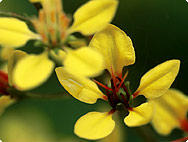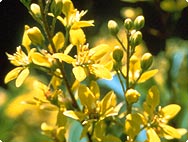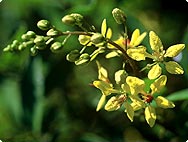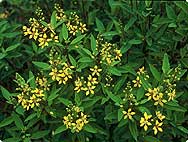A.Vogel search
When the internal search is activated, personal data such as your IP address is transmitted to our search engine Cludo. Data is thus transferred to a third country. Please click here if you want to display the internal search. You can find more information on data protection here: Privacy policy.
Galphimia glauca CAV.
Galphimia
History

Galphimia glauca is to be found extensively in tropical America; it belongs to a small family of plants – Malpighiaceae - that has not been the subject of much research as yet. One well known species is the Acerola cherry which is indigenous to Florida. The fruits of this plant are rich in vitamin C. In Mexican folk medicine, the plant is known as noche buena (“good night”). A tea made from the plant’s yellow leaves is used to relieve coronary pain as well as to soothe the nerves. Galphimia is also used in mixed tea infusions to treat diarrhoea, dysentry and gastroenteritis. Medicine men from some of the Native tribes living in the rain forests of Brazil and Mexico use the plant to treat allergic rhinitis and pollinosis. During a plant-gathering expedition to South America in the mid-sixties, Willmar Schwabe’s attention was brought to the anti-allergic effects of this plant, which prompted him to gather sufficient plant material and bring it back to Germany. Since then, the plant’s homeopathic properties have been the subject of a series of experiments which were found to be positive.
Botanical characteristics

Galphimia glauca is a robust, evergreen shrub which grows to a height of between 1 and 1.8 metres. The trunk is covered with reddish fibres; the leaves are thin and leathery and blueish-greyish green in colour. They are about 5 cm long and are either elliptical, oval or bluntly rounded off at their base. The leaves are arranged alternately along the thin branches. The shrub’s yellow flowers are 2 cm in size and have two outer leaves, 5 sepals and 5 petals, 10 anthers which are alternately short and long, and 3 styles. They form long, terminal panicles which bloom in waves in warm weather. This plant blooms a great deal; this fact, coupled with its quick growth rate makes Galphimia a popular garden plant. Moreover, this shrub is fairly capable of adapting to drier climes and can even withstand mild frosts of up to -2º C. In colder regions the plant is perennial and must be placed in a greenhouse during the winter months. The shrub blooms at different times of the year, depending on where it is planted.
Habitat

This shrub is indigenous to the dry regions of Central and South America, particularly Mexico, Guatemala and Panama.
Preparation

The plant’s dried leaves and flowers are macerated in alcohol and shaken by hand to obtain the required potency.
A.Vogel Blog – Natural and Healthy
Inspiration for a healthy life!




